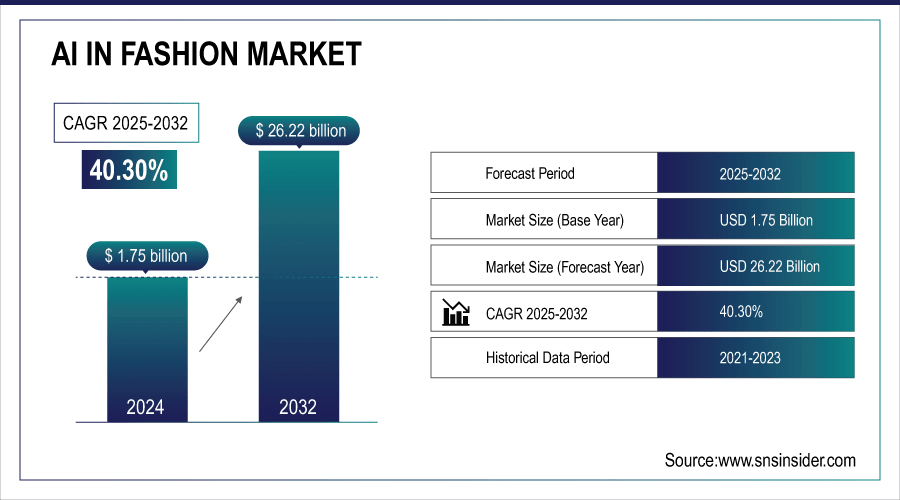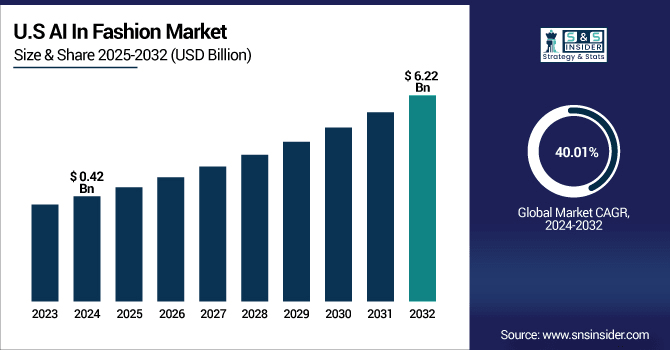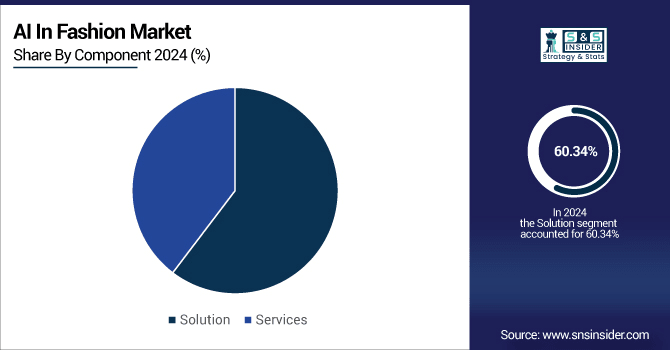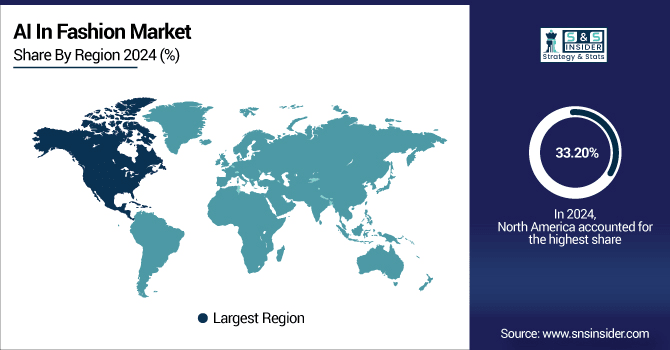AI In Fashion Market Report Scope & Overview:
The AI In Fashion Market Size was valued at USD 1.75 billion in 2024 and is expected to reach USD 26.22 billion by 2032 and grow at a CAGR of 40.30% over the forecast period 2025-2032.
The AI in Fashion Market is witnessing rapid growth, primarily driven by the increasing adoption of AI technologies across the fashion value chain. Fashion brands are leveraging AI-powered solutions for personalized product recommendations, trend forecasting, and creative designing, which enhances customer engagement and boosts sales conversion rates. The growth of e-commerce platforms and digital shopping experiences has further accelerated the demand for AI tools, as consumers increasingly expect tailored, seamless, and interactive experiences. Additionally, advancements in machine learning, computer vision, and natural language processing enable more accurate prediction of fashion trends, optimized inventory management, and smarter supply chain operations, making AI a critical enabler for efficiency and profitability. According to study, 74% of fashion companies have adopted AI for trend forecasting and inventory management, aiming to reduce waste and optimize planning.

To Get More Information On AI In Fashion Market - Request Free Sample Report
AI In Fashion Market Size and Forecast:
-
Market Size in 2024: USD 1.75 Billion
-
Market Size by 2032: USD 26.22 Billion
-
CAGR: 40.30% from 2025 to 2032
-
Base Year: 2024
-
Forecast Period: 2025–2032
-
Historical Data: 2021–2023
AI In Fashion Market Trends
-
Highly personalized shopping experiences, thanks to AI-powered recommendation engines and predictive analytics are becoming commonplace
-
Adoption of virtual try-ons and digital fitting tools are providing customer interaction channels on e-commerce and retail platforms.
-
AI based supply chain optimization to prevent over production and reduce inventory wastage.
-
Fashion companies are increasingly using AI to predict trends and to help guide production against consumer demand.
-
Advanced personalization technologies can be adapted and deployed by small and medium enterprises using cloud-based AI solutions.
-
Sustainable AI uses artificial intelligence to drive the use of sustainable materials and consumption.
-
The rise of Design AI and Retail AI among designers and retail stores are increasing productivity and sales conversion, respectively.
The U.S. AI In Fashion Market size was USD 0.42 billion in 2024 and is expected to reach USD 6.22 billion by 2032, growing at a CAGR of 40.01% over the forecast period of 2025-2032. driven by advanced technological infrastructure, high digital adoption, and a mature e-commerce ecosystem.

AI In Fashion Market Segment Analysis
-
By Component: In 2024, Solution led the market with share 60.34%, while Services are the fastest-growing segment with a CAGR 40.22%.
-
By Deployment: In 2024, Cloud led the market 55.10%, while fastest-growing segment with a CAGR 40.55%.
-
By Application: In 2024, Product Recommendation led the market with share 26.40%, while Product Search and Discovery are the fastest-growing segment with a CAGR 41.71%.
-
By Type: In 2024, Apparel led the market with share 45.20%, while Accessories is the fastest-growing segment with a CAGR 42.50%.
-
By End-User: In 2024, Fashion Designers led the market with share 60.20%, while is the fastest-growing segment with a CAGR 40.47%.
By Component, Solution Lead Market While Services Fastest Growth
The AI in fashion market is largely divided into Solutions and Services of which, the solutions segment held the largest share of the market. The reason behind this dominance is the increasing use of AI-enabled tools for product recommendations, trend forecasting, virtual try-ons, and inventory optimization. Fashion brands are increasingly reliant on advanced AI software solutions to provide the world with more personalized outfits for the masses, cut company costs, and win at the sneakers game price slope. At the same time, the Services segment is experiencing the highest growth, since brands specifically SMEs are increasingly looking for someone else to implement, maintain, and find the best way to utilize AI systems. Offerings include system integration, consulting, training and technical support. Partially due to the increased requirement for niche AI skill, and partly because of difficulty in deploying and managing AI solutions, this segment is set to grow quickly.

By Deployment, Cloud Lead Market While is Fastest Growth
The Cloud segment holds the largest share of the market, due to the numbers of benefits such as scalability, flexibility, and cost-effectiveness. Fashion brands can also roll out new tools for personalization, trend forecasting, virtual try-on, and supply chain optimization thanks to cloud-based AI solutions that require no substantial upfront infrastructure investments. Cloud platforms also help in integrating across various channels, such as e-commerce, retail stores and design studios to enable real-time access to data and analytics for better decision-making. At the same time, the On-Premises segment is projected to experience the highest growth rate because certain fashion brands demand higher levels of control over their data and AI systems, particularly when it comes to sensitive customer data or their proprietary designs. Deployments on site allow for greater security, more flexibility, and adherence to internal IT policies.
By Application, Product Recommendation Lead Market While Product Search and Discovery Fastest Growth
The Product Recommendation segment dominates the market due to the increasing need for customized shopping experiences. Using AI algorithms, these recommendation engines analyse the consumer behavior, purchase history and preferences to help suggest relevant products to the consumer which leads to higher customer engagement, higher conversion rates, and increased sales performance. On the other hand, the Product Search and Discovery vertical experiences the highest growth rate, because customers are expecting better ways to search for the products they want. AI-powered search engines, visual search, and natural language processing allow users to discover products more quickly and accurately, enhancing user experience and shortening the search time. The growth of online fashion retail and the emergence of innovative AI-powered search tools are expected to aid in the adoption of this application segment at a rapid pace making it a significant growth area in the market.
By Type, Apparel Leads Market While Accessories Fastest Growth
The market is segmented into Apparel, Retail, and Others, with Apparel being the leading segment, as the demand for AI-powered solutions capabilities for personalization, trend forecasting, at home virtual try-ons, and inventory, is higher in clothing. Apparel continues to lead by market share with fashion brands pouring more money into AI technologies to facilitate personalized shopping experiences, accelerate design processes, and optimize operational efficiencies. At the same time, the Accessories segment is growing most rapidly, thanks to the growing interest among consumers in personalized and AI-recommended products such as bags, belts, hats and eyewear. In the accessories category, AI technologies enable brands to provide personalized recommendations, facilitate inventory management, and enhance customer interactions.
By End-Use, Fashion Designers Lead Market While is Fastest Growth
Fashion Designers segment held a dominant position in the market due to the growing adoption of AI-powered tools for creative designing, forecast trends, virtual prototyping, and personalized product recommendations. By using AI, designers are able to determine consumer preferences, predict future trends, and create collections that meet market needs which increases efficiency and decreases design errors. Rather, designers represent the largest end-user segment of AI because integrating AI into the design process allows brands to compete better and innovate faster. On the other hand, the Fashion Stores segment is gaining the highest pace step as the retailers are progressively embracing AI solutions for improving customer experiences, offering inventory optimization, product search and discovery and personalized recommendation.
AI In Fashion Market Growth Drivers:
-
Rising Demand for Personalized Fashion Experiences Fuels AI Adoption
The increasing consumer demand for personalized shopping experiences is the major factor driving the AI in Fashion Market. Today, shoppers expect products and services that fit their unique preferences, style, and even size. AI driven solutions such as recommendation engines, virtual try-ons or predictive analytics enable these fashion brands to provide these personalized experiences at scale. Using consumer data such as browsing behaviour, purchasing history, and social media activity, AI can identify fashion trends and offer products that match personal taste. Making personalized notable high involvement factor triggering market growth driving customer satisfaction, engagement, conversion rates and loyalty which are further rising factors for increasing growth in market.
Over 30% of fashion brands have adopted AI for virtual try-ons and size recommendations, improving customer satisfaction.
AI In Fashion Market Restraints:
-
High Implementation Costs Limit AI Adoption Among Small and Medium Fashion Brands
High cost involved in implementation of AI solutions is a major restraint for AI in Fashion Market. AI is deployed on a very sophisticated software tool, requiring cloud infrastructure, and people that know how to build, run, and maintain AI systems. Much of these upfront costs can be cost prohibitive for small and medium-sized fashion enterprises. Moreover, embedding AI into legacy systems may also take considerable IT spend and need continuous upkeep, which increases operational costs. That cost is a limiting factor preventing adoption, especially by smaller brands and retailers and, as a result, can slow market segmentation.
AI In Fashion Market Opportunities:
-
Leveraging AI to Drive Sustainability and Optimize Fashion Supply Chains
The AI in Fashion Market has a huge opportunity for growth by utilizing AI in sustainability initiatives. The second activity that annoys the fashion world with overproduction and waste, and here AI can also solve the problem. AI allows brands to understand demand trends, estimate inventory levels, and facilitate optimal supply chains so that the correct numbers get made at the correct times to avoid overstock and wastage. Moreover, AI can also help identify sustainable materials and create sustainable products, aiding fashion brands in addressing the increasing consumer demand for sustainable practices. With rising environmental concerns, firms implementing AI for sustainability not only have a leg up on the competition, but also boost efficiency and accountability throughout whole sectors.
AI-driven supply chain optimization reduced overproduction and waste by up to 20–25% in fashion brands in 2024.
North America AI In Fashion Market Insights:
North America dominates the AI in Fashion Market growth share 33.20%, on account of presence of well-established fashion brands along with advanced technological infrastructure which in turn boost the consumer awareness about AI-enabled shopping experience. It has a strong e-commerce ecosystem, significant investment in AI R&D, and an almost universal adoption of digital tools for personalization, virtual try-ons, and trend forecasting. North America accounts for the largest share by capital of North American fashion companies competitively investing in AI solutions to engage customers, and manage their inventory with an immediate strategy into years of evolution to the market.

Get Customized Report as Per Your Business Requirement - Enquiry Now
-
U.S. Dominates AI in Fashion Market with Advanced Technological Adoption
The U.S. dominates the AI in Fashion Market, driven by advanced technological infrastructure, high adoption of AI in retail and e-commerce, and a strong presence of leading fashion brands. Companies are leveraging AI-powered personalization, virtual try-ons, and predictive analytics to enhance customer experiences and optimize operations.
Asia-Pacific AI In Fashion Market Insights
The Asia Pacific is currently the fastest-growing region with a CAGR 40.94%, due to the increase in adoption of AI technologies in the emerging countries such as China, India, Japan, and South Korea. Demand for personalized shopping experiences and AI-powered fashion solutions in the region is being fueled by an expanding e-commerce sector, a growing middle-class population, and rising smartphone penetration. Furthermore, the establishment of various government initiatives for digital transformation and the readiness of local and foreign fashion brands to invest in Artificial Intelligence tools for design, supply chain, and customer engagement have contributed to the rapid growth of the market, making Asia Pacific the fastest-growing region in the global AI in Fashion Market.
-
China and India Propel Rapid Growth in AI in Fashion Market
China and India are rapidly growing AI in Fashion markets, driven by booming e-commerce, rising internet and smartphone penetration, tech-savvy consumers, and government support, with brands increasingly deploying AI for personalization, trend forecasting, virtual try-ons, and supply chain optimization.
Europe AI In Fashion Market Insights
Europe accounts for a large share of the AI in Fashion Market due to high end fashion houses, luxury brands, and strong technological infrastructure. The U.K., Germany, France, and Italy are at the forefront of integrating AI-based solutions for personalization, trend predictions, virtual fitting, and inventory management. Moving forward, European fashion brands are keen on investing in AI to improve customer experience, supply chain optimization and to remain competitive in a digitally changing market. Moreover, the region has been additionally supported by government initiatives accelerating global digital transformation, sustaining AI-focused research, and transitioning to sustainable fashion methods, driving the use of AI throughout the fashion sector.
-
Germany and U.K. Lead AI in Fashion Market Expansion Across Europe
The U.K. and Germany lead Europe’s AI in Fashion Market, driven by advanced retail and e-commerce infrastructure, high digital adoption, AI-powered personalization, trend forecasting, virtual try-ons, supply chain optimization, and sustainability-focused smart solutions, accelerating market growth.
Latin America (LATAM) and Middle East & Africa (MEA) AI In Fashion Market Insights
Latin America and Middle East & Africa AI in Fashion Market the AI in Fashion Market in Latin America and Middle East & Africa are expected to grow due to increasing e-commerce and digital retail, the adoption of AI-based personalization in retail, and luxury fashion. A growing number of smartphone penetration, company assistance and digital change efforts are boosting cellular AI implementation to forecast styles, provide virtual try-ons, optimize inventory, and provide better customer experiences.
AI In Fashion Market Competitive Landscape
Microsoft develops AI-powered platforms and solutions that enhance digital experiences across industries, including retail and fashion. Its tools support personalized recommendations, trend forecasting, and immersive shopping experiences, enabling brands to deliver data-driven insights and optimized customer engagement.
-
In May 2025, Microsoft partnered with Curated for You to integrate AI-powered fashion suggestions into its Copilot assistant, enabling personalized shopping experiences through natural language interactions.
Amazon Web Services (AWS) provides scalable cloud infrastructure and AI solutions to support enterprise-wide digital transformation, including manufacturing, logistics, and retail. Its AI-powered services enhance operational efficiency, predictive analytics, and automation across diverse sectors.
-
In August 2025, AWS extended its partnership with Volkswagen for another five years to enhance its 'factory cloud' initiative, aiming to reduce production costs and improve operational efficiency with artificial intelligence.
SAP offers AI-enabled enterprise software and generative AI copilot solutions, assisting businesses in automation, personalization, and real-time analytics. Its platforms streamline workflows, optimize decision-making, and deliver intelligent business outcomes across industries.
-
In May 2025, SAP unveiled plans to make its Joule AI agent omnipresent across its platform, aiming to create seamless AI assistance within SAP and extend to other business applications.
AI In Fashion Market Key Players:
Some of the AI In Fashion Market Companies are:
-
Microsoft
-
Google
-
Amazon Web Services (AWS)
-
IBM
-
SAP
-
Oracle
-
Adobe
-
Lily AI
-
Catchoom
-
Heuritech
-
FINDMINE
-
Vue.ai
-
Mode.ai
-
Stylumia
-
True Fit
-
Stitch Fix
-
LVMH
-
Alibaba (FashionAI)
-
Perfect Corp.
-
3DLOOK
| Report Attributes | Details |
|---|---|
| Market Size in 2024 | USD 1.75 Billion |
| Market Size by 2032 | USD 26.22 Billion |
| CAGR | CAGR of 40.30% From 2025 to 2032 |
| Base Year | 2024 |
| Forecast Period | 2025-2032 |
| Historical Data | 2021-2023 |
| Report Scope & Coverage | Market Size, Segments Analysis, Competitive Landscape, Regional Analysis, DROC & SWOT Analysis, Forecast Outlook |
| Key Segments | •By Component (Solution, Services) •By Deployment (Cloud, On-Premises) •By Application (Product Recommendation, Product Search and Discovery, Supply Chain Management and Demand Forecasting, Creative Designing and Trend Forecasting, Customer Relationship Management, Virtual Assistants) •By Type (Apparel, Accessories, Footwear, Beauty and Cosmetics, Jewelry and Watches) •By End-User (Fashion Designers, Fashion Stores) |
| Regional Analysis/Coverage | North America (US, Canada), Europe (Germany, UK, France, Italy, Spain, Russia, Poland, Rest of Europe), Asia Pacific (China, India, Japan, South Korea, Australia, ASEAN Countries, Rest of Asia Pacific), Middle East & Africa (UAE, Saudi Arabia, Qatar, South Africa, Rest of Middle East & Africa), Latin America (Brazil, Argentina, Mexico, Colombia, Rest of Latin America). |
| Company Profiles | Microsoft, Google, Amazon Web Services (AWS), IBM, SAP, Oracle, Adobe, Lily AI, Catchoom, Heuritech, FINDMINE, Vue.ai, Mode.ai, Stylumia, True Fit, Stitch Fix, LVMH, Alibaba (FashionAI), Perfect Corp., 3DLOOK, and Others. |

